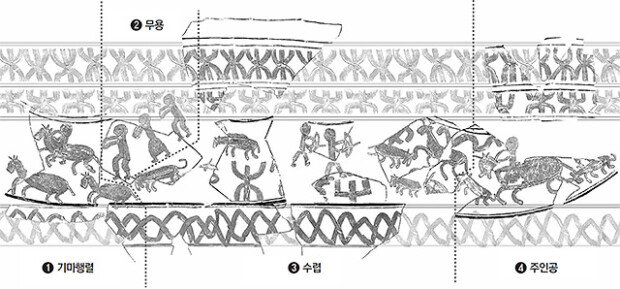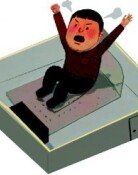5th-centuty earthenware fragments found at a grave in Gyeongju
5th-centuty earthenware fragments found at a grave in Gyeongju
Posted October. 17, 2019 07:29,
Updated October. 17, 2019 07:29
Man on a horse is heading somewhere with an animal that looks like a dog. Some are pulling a string aimed at dears and other game. Others seem to be dancing as they follow the cavalcade. Is this an image of the grave owner’s living years from 1,500 years ago or an image wishing a glorious life in the afterlife?
A fifth-century long-necked jar with such an image of a grand parade was excavated from the Jjoksam district grave No. 44 in Hwango-dong, Gyeongju, North Gyeongsang Province. “This is the first earthenware found with such a complex image of a big parade involving people riding on a horse, dancing, and hunting,” said Lee Jong-hoon, head of the Gyeongju National Research Institute of Cultural Heritage, on Wednesday. “It is a valuable relic with rich content and high importance as a painting work.”
Fragments of the earthenware with the parade picture were found in the layer of pebbles north of the stone structure surrounding the grave. There were four layers of patterns, the first, second, and fourth of which show repetitive geometric patterns while the third one features humans and animals, including dears, boars, horses, and dogs. Such patterns and drawings were engraved as if sweeping with a tool similar to a comb. It is believed to have been used for a memorial ceremony and its original height is estimated to be about 40 centimeters.
The newly found jar is drawing more attention, in particular because its parade theme resembles ancient tomb murals of ancient Korean kingdom Goguryeo, such as Muyeongchong’s mural paintings featuring hunting and dancing and the parade painting of Anak grave No. 3. For example, the drawing of a horse’s mane tied to look like a horn is found in the parade painting of Anak grave No. 3 while people holding their arms side-by-side resemble those in Muyeongchong’s paintings. The dog standing with the protagonist of the parade is deemed as a protector of the grave, which is also a feature found in paintings of Goguryeo.
The earthenware found in Gyeongju seems to be a piece of evidence that Silla, a kingdom located in southern and central parts of the Korean Peninsula, received cultural influence from Goguryeo in the early fifth century when the two had a close relationship. There has been no earthenware of pre-fifth-century Silla featuring an image of a parade that resembles a landscape painting. “Hunting and parades are a common theme in the paintings related to funerals in Goguryeo and China,” said Professor Jeon Ho-tae of history and culture at University of Ulsan. He explained that pictorial elements found in the newly excavated jar of Silla seem to have been under direct influence of Goguryeo’s then-flourishing culture after A.D. 400.
In addition to the jar, two bowl stands were also excavated from Jjoksam district grave No. 44. It features the mane, hoofs, and joints of two horses. The cross stripes on their body are seen as their armor. Moreover, over 110 memorial ceremony relics, including nine large pots, were found near the grave’s stone structure.

Jong-Yeob JO jjj@donga.com







